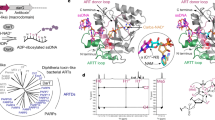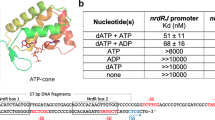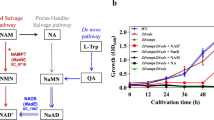Abstract
Regulation of cellular levels of ADP-ribose is important in preventing nonenzymatic ADP-ribosylation of proteins. The Escherichia coli ADP-ribose pyrophosphatase, a Nudix enzyme, catalyzes the hydrolysis of ADP-ribose to ribose-5-P and AMP, compounds that can be recycled as part of nucleotide metabolism. The structures of the apo enzyme, the active enzyme and the complex with ADP-ribose were determined to 1.9Å, 2.7Å and 2.3Å, respectively. The structures reveal a symmetric homodimer with two equivalent catalytic sites, each formed by residues of both monomers, requiring dimerization through domain swapping for substrate recognition and catalytic activity. The structures also suggest a role for the residues conserved in each Nudix subfamily. The Nudix motif residues, folded as a loop-helix-loop tailored for pyrophosphate hydrolysis, compose the catalytic center; residues conferring substrate specificity occur in regions of the sequence removed from the Nudix motif. This segregation of catalytic and recognition roles provides versatility to the Nudix family.
This is a preview of subscription content, access via your institution
Access options
Subscribe to this journal
Receive 12 print issues and online access
$189.00 per year
only $15.75 per issue
Buy this article
- Purchase on Springer Link
- Instant access to full article PDF
Prices may be subject to local taxes which are calculated during checkout




Similar content being viewed by others
References
Just, I., Wollenberg, P., Moss, J. & Aktories, K. Cysteine-specific ADP-ribosylation of actin. Eur. J. Biochem. 221, 1047–1054 (1994).
Ueda, K., Kawaichi, M., Okayama, H. & Hayaishi, O. Poly(ADP-ribosy)ation of nuclear proteins. Enzymatic elongation of chemically synthesized ADP-ribose-histone adducts. J. Biol. Chem. 254, 679–687 (1979).
Han, M.K., Cho, Y.S., Kim, Y.S., Yim, C.Y. & Kim, U.H. Interaction of two classes of ADP-ribose transfer reactions in immune signaling. J. Biol. Chem. 275, 20799–20805 (2000).
Moss, J. & Zahradka, P. (guest editors) ADP-ribosylation: metabolic effects and regulatory function. Mol. Cell. Biochem. 138, 1–253 (1994).
McDonald, L.J. & Moss, J. Enzymatic and nonenzymatic ADP-ribosylation of cysteines. Mol. Cell. Biochem. 138, 221–226 (1994).
Fernandez, A. et al. Specific ADP-ribose pyrophosphatase from Artemia cysts and rat liver: effects of nitroprusside, fluoride and ionic strength. Biochim. Biophys. Acta 1290, 121–127 (1996).
Ribeiro J.M., Costas, M.J. & Cameselle J.C. ADP-ribose Pyrophosphatase-I partially purified from livers of rats overdosed with acetaminophen reveals enzyme inhibition in vivo reverted in vitro by dithiothreitol. J. Biochem. Mol. Tox. 13, 171–177 (1999).
Kim, J. et al. Purification and characterization of adenosine diphosphate ribose pyrophosphatase from human erythrocytes. Int. J. Biochem. Cell Biol. 30, 629–638 (1998).
Dunn, C.A., O'Handley, S.F., Frick, D.N. & Bessman, M.J. Studies on the ADP-ribose pyrophosphatase subfamily of the nudix hydrolases and tentative identification of trgB, a gene associated with tellurite resistance. J. Biol. Chem. 274, 32318–32324 (1999).
Gasmi, L., Cartwright, J.L. & McLennan, A.G. Cloning, expression and characterization of YSA1H, a human adenosine 5′-diphosphosugar pyrophosphatase possesing a MutT motif. Biochem. J. 344, 331–337 (1999).
O'Handley, S.F., Frick, D.N., Dunn, C.A. & Bessman, M.J. Orf186 represents a new member of the Nudix hydrolases, active on adenosine(5′)triphospho(5′) adenosine, ADP-ribose and NADH. J. Biol. Chem. 273, 3192–3197 (1998).
Raffaelli, N. et al. Synechocystis sp. s1r0787 protein is a novel bifunctional enzyme endowed with both nicotinamide mononucleotide adenylyltransferase and Nudix hydrolase activityies. FEBS Lett. 444, 222–226 (1999).
Sheikh, S., O'Handley, S.F., Dunn, C.A. & Bessman, M.J. Identification and characterization of the Nudix hydrolase from the Archaeon, Methanococcus jannaschii, as a highly specific ADP-ribose pyrophosphatase. J. Biol. Chem. 273, 20924–20928 (1998).
Yang, H. et al. Cloning and characterization of a new member of the nudix hydrolases from human and mouse. J. Biol. Chem. 275, 8844–8853 (2000).
Bessman, M.J., Frick, D.N. & O'Handley, S.F. The MutT proteins or 'Nudix' hydrolases, a family of versatile, widely distributed, 'housecleaning' enzymes. J. Biol. Chem. 271, 25059–25062 (1996).
Abeygunawardana, C. et al. Solution structure of the MutT enzyme, a nucleoside triphosphate pyrophosphohydrolase. Biochemistry 34, 14997–15005 (1995).
Swarbrick, J. et al. The three dimensional structure of the Nudix enzyme diadenosine tetraphosphate hydrolase from Lupinus angustifolius L. J. Mol. Biol. 302, 1165–1177 (2000).
Favas, M.C., Kepert, D.L. & Skel, B.W. Crystal structure of gadolinium (III) acetate tetrahydrate. Sterochemistry of the nine-coordinate [M(bidentate ligand)3(unidentated ligand)3] system. J. Chem. Soc. 454–458 (1980).
Allen, F.H. & Kennard, O. 3D search and research using the Cambridge Structural Database. Chemical Design Automation News 8, 31–37 (1993).
Cotton, F. & Wilkinson, G. In Advanced inorganic chemistry, 986–987 (John Wiley & Sons, London; 1980).
Navia, M.A. et al. Three dimensional structure of aspartyl protease from human imnunodeficiency virus HIV-1. Nature 16, 615–620 (1989).
Denessiouk, K.A. & Johnson, M.S. When fold is not important: a common structural framework for adenine and AMP binding in 12 unrelated protein families. Proteins 38, 310–326 (2000).
Han, S., Craig, J.A., Putnam, C.D., Carozzi, N.B. & Tainer, J.A. Evolution and mechanism from structures of an ADP-ribosylating toxin and NAD complex. Nature Struct. Biol. 6, 932–936 (1999).
Altschul, S.F. et al. Gapped BLAST and PSI-BLAST a new generation of protein database search programs. Nucleic Acids Res. 25, 3389–3402 (1997).
Lin, J., Abeygunawardana, C., Frick, D.N., Bessman, M.J. & Mildvan, A.S. Solution structure of the quaternary MutT-M2+–AMPCPP-M2+ complex and mechanism of its pyrophosphohydrolase action. Biochemistry 36, 1199–1211 (1997).
Otwinowski, Z. & Minor, W. Processing of X-ray diffraction data collected in oscillation mode. Methods in Enzymol. 277, 307–326 (1997).
Terwilliger, T.C. & Berendzen, J. Automated structure solution for Mir and Mad. Acta Crystallogr. D 55, 849–861 (1999).
Cowtan, K.D. An automated procedure for phase improvement by density modification. Joint CCP4 and ESF-EACBM Newslett. Protein Crystallogr. 31, 34–38 (1994).
Kleywegt, G.J. & Jones, T.A. Software for handling macromolecular envelopes. Acta Crystallogr. D 55, 941–944 (1999).
Kleywegt, G.J. & Jones, T.A. Halloween...Masks and Bones. in From first map to final model (eds Bailey, S., Hubbard, R. & Waller, D.) 59–66 (SERC, Daresbury Laboratory, Warrington; 1994).
Jones, T.A., Zou, J.Y., Cowan, S.W. & Kjelgaard, M. Improved methods for binding protein models to electron density maps and the location of errors in these models. Acta Crystallogr. A 42, 110–119 (1991).
Jones. T.A. & Kjeldgaard, M. Electron-density map interpretation. Methods Enzymol. 277, 173–208 (1997).
Brunger, A.T. et al. Crystallography,NMR system: A new software suite for macromolecular structure determination. Acta Crystallogr. D 54, 905–921 (1998).
Brunger, A.T. Free R value: Cross-validation in crystallography. Methods Enzymol. 277, 366–396 (1997).
Laskowski, R., MacArthur, M., Moss, D. & Thornton, J. PROCHECK: a program to check the sterochemical quality of protein structures. J. Appl. Crystallogr. 26, 283–291 (1993).
Kraulis, J. MOLSCRIPT: a program to produce both detailed and schematic plots of protein structure. J. Appl. Crystallogr. 24, 946–950 (1991).
Esnouf, R.M. Further additions to MOLSCRIPT version 1.4, including reading and countouring of electron density maps. Acta Crystallogr. D 55, 938–940 (1999).
Merrit, E. & Bacon, D. Raster3D: Photorealistic molecular graphics. Methods Enzymol. 277, 505–524 (1997).
Acknowledgements
Support was provided by NIGMS grants to L.M.A. and M.J.B. S.B.G was supported by an NSF graduate fellowship. Beamlines X25, X8C and X9B of National Synchrotron Light Source, Brookhaven National Laboratory are gratefully acknowledged. We thank D. Leahy for carefully reading the manuscript.
Author information
Authors and Affiliations
Corresponding author
Rights and permissions
About this article
Cite this article
Gabelli, S., Bianchet, M., Bessman, M. et al. The structure of ADP-ribose pyrophosphatase reveals the structural basis for the versatility of the Nudix family. Nat Struct Mol Biol 8, 467–472 (2001). https://doi.org/10.1038/87647
Received:
Accepted:
Issue Date:
DOI: https://doi.org/10.1038/87647
This article is cited by
-
Structural analyses of NudT16–ADP-ribose complexes direct rational design of mutants with improved processing of poly(ADP-ribosyl)ated proteins
Scientific Reports (2019)
-
Trpm2 Ablation Accelerates Protein Aggregation by Impaired ADPR and Autophagic Clearance in the Brain
Molecular Neurobiology (2019)
-
Alr2954 of Anabaena sp. PCC 7120 with ADP-ribose pyrophosphatase activity bestows abiotic stress tolerance in Escherichia coli
Functional & Integrative Genomics (2017)
-
A comprehensive structural, biochemical and biological profiling of the human NUDIX hydrolase family
Nature Communications (2017)
-
Structural basis of prokaryotic NAD-RNA decapping by NudC
Cell Research (2016)



